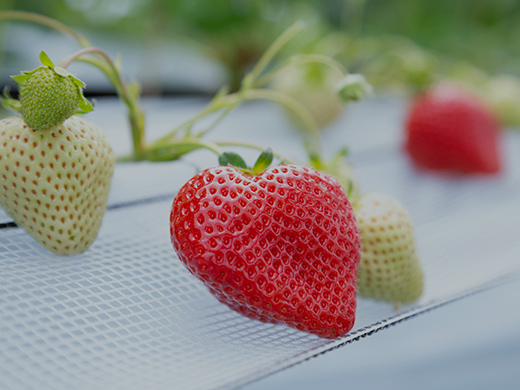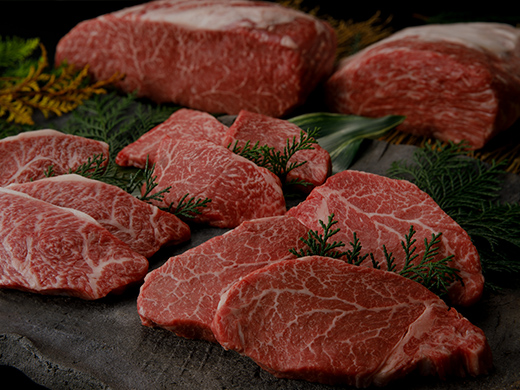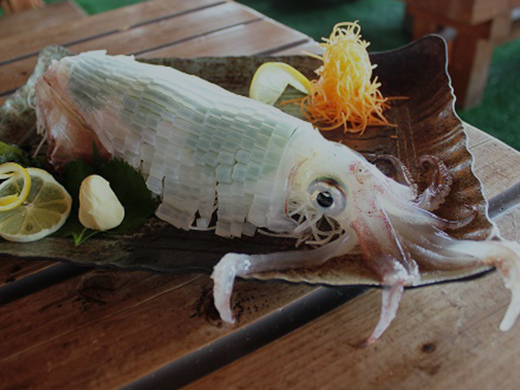- Agricultural Produce
- Animal Products
- Seafood

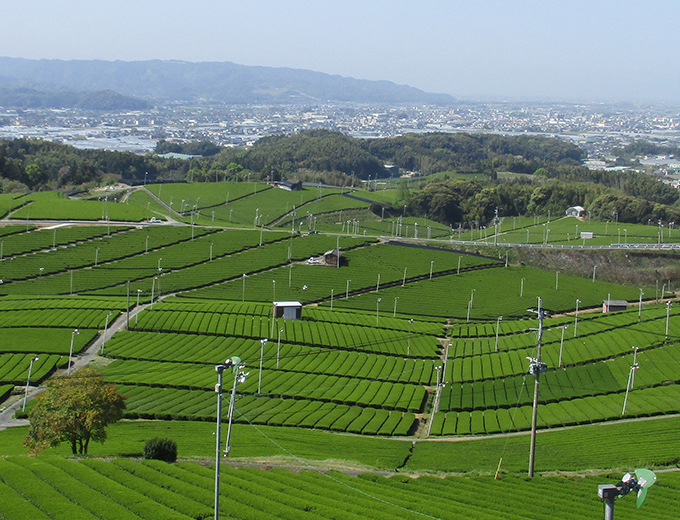

The arable land area of Fukuoka Prefecture is 81,400 ha (2018), which accounts for 16% of the prefecture's total land area. Of this, 80% comprises rice paddies (national average of 54%). Fukuoka Prefecture also focuses on the branding of ingredients, some of which are popular not only in the prefecture but also in other parts of the country.
-
 foods 01
foods 01Genki Tsukushi
This is a rice variety developed in 2008 by Fukuoka Prefecture, which has long been a prosperous rice-growing area and one of the largest production centers in western Japan. Growing vigorously even in the heat of summer, Genki Tsukushi has firm and bright grains. The rice tastes good not only when it has just been cooked, but also even when it is cold. The name expresses the developer’s hope that the rice will grow vigorously even in the heat and the rice will energize the consumers.
-
 foods 02
foods 02Rah-mugi Wheat
This wheat has been developed by Fukuoka Prefecture as an ingredient of ramen noodles. Noodles made from this wheat have a firm but crisp texture and a good color.
To cultivate Rah-mugi, producers make various efforts, such as treading the wheat and adding fertilizer. This increases the protein content and helps to produce firm noodles. Currently, approximately 170 ramen shops (as of the end of March 2022), mainly in Fukuoka Prefecture, offer ramen noddles made from Rah-mugi. -
 foods 03
foods 03Hakata Tsubomina Mustard Green
Called a vegetable that heralds the arrival of spring, Hakata Tsubomina is a type of large mustard green native to China.
During the cold season, each small bud is carefully plucked by hand one at a time from among the thick leaves around it.
It has a refreshing sweetness but also a tangy spiciness. Even if heated, the vegetable maintains its crunchy texture. -
 foods 04
foods 04Hakata Eggplant
Hakata Eggplant is a type of long eggplant cultivated in Fukuoka Prefecture for more than half a century. Hakata is one of the largest eggplant producers in Japan. This lustrous, purplish-blue eggplant is soft, even if eaten with the peel, and is not so bitter. Of the various eggplants produced with reliable techniques refined over a long history, only eggplants that meet strict standards for size and color are allowed to be called Hakata Eggplant.
-
 foods 05
foods 05Bamboo Shoots
Bamboo shoots herald the arrival of spring. Fukuoka Prefecture is one of the largest bamboo shoot producers. In Yame City, the main production area of the prefecture, there is an abundance of fertile land appropriate for growing bamboo shoots. Some records say that production began in the Edo period. Since bamboo groves are dotted both on the flatlands and in the mountains, bamboo shoots can be shipped for a long period of time from the end of October to the end of May.
Especially renowned is Ouma Bamboo Shoot, a brand from Ouma in Kitakyushu. To produce this brand, high-quality red soil is added to the ground before the bamboo shoots emerge. -
 foods 06
foods 06Amaou Strawberry
Amaou is a top strawberry brand. The name Amaou, a variety developed by Fukuoka Prefecture, is an acronym of akai (red), marui (round), ookii (big), and umai (delicious). Featuring large, red, juicy flesh, rich sweetness, and appropriate acidity, this is the king of strawberries.
To ensure that the strawberries are shipped in compliance with all the strict standards of size, shape, color, etc., producers handle each strawberry very carefully. We hope you will enjoy the excellence of the strictly selected top brand Amaou! -
 foods 07
foods 07Akiou Persimmon
Akiou, meaning “the king of autumn” in Japanese, is a persimmon brand developed over 10 years by Fukuoka Prefecture, one of Japan’s largest persimmon producers. As a hybrid of Fuyu, a typical example of a sweet persimmon, and Taishu, which has a crispy texture, this is the world’s first sweet persimmon almost without seeds. Featuring a large size and high sugar content, the persimmon has a crispy texture and juicy flesh.
-
 foods 08
foods 08Amawi Kiwifruit
Amawi (sweet kiwifruit) is a variety developed over approximately eight years by Fukuoka Prefecture, one of the largest kiwifruit centers in Japan. As indicated by its name, this kiwifruit features a refreshing sweetness and large and yellowish flesh. The fruit is force-ripened in the production area until it is just right for eating. This process brings out its original sweetness.
-
 foods 09
foods 09Toyomitsuhime
Toyomitsuhime is a fig developed by Fukuoka Prefecture, one of the largest fig producers in Japan. As indicated by its average sugar content of at least 17 degrees Brix, this fig is very sweet.
Its peel is so thin that you can eat the fig without peeling it. The fig features a thick and dense flesh and a smooth texture. It is shipped from early summer to early autumn and is popular with people of all ages at sweet shops. -
 foods 10
foods 10Sake
Kyushu is home not only to the largest river in the Kyushu region, the Chikugo River, but also to other Class A rivers, such as the Yabe River and the Onga River. In Fukuoka Prefecture, which is rich in high-quality water essential for making sake, there are 66 sake breweries, making the prefecture one of the largest sake production centers in Japan.
Fukuoka Prefecture is also one of Japan’s largest producers of Yamada Nishiki, a representative example of rice suitable for sake brewing. The prefecture also actively produces Yume Ikkon, which is the prefecture’s proprietary rice for sake brewing, and Ginnosato, which has been developed by the country and is suitable for cultivation in Kyushu. In addition, the prefecture has a long history of distilling shochu. Each maker’s ingenuity and passion lead the evolution of shochu production. Together with sake, shochu underpins Fukuoka Prefecture’s rich food culture. -
 foods 11
foods 11Yame Tea Leaves (Yame Traditional Hon Gyokuro)
Tea leaves from Yame, Fukuoka, which are luxurious leaves with a mellow, excellent flavor, attract consumers both in Japan and abroad due to their high quality. At the FY2022 National Tea Leaves Fair, Yame City was commended as an excellent producer in the Category of Gyokuro for the 22nd straight year and in the Category of 4kg Sencha for the second straight year. To produce Yame Traditional Hon Gyokuro, straw is placed on frames over the tea bushes for at least 16 days to avoid sunlight. In addition, each leaf is carefully plucked by hand without pruning. Produced in this traditional method, Yame Traditional Hon Gyokuro became the first tea leaves in December 2015 to be placed on the list of Japan Geographical Indication (GI)*
*This registration system is intended to protect the names of products as intellectual property (geographical indications) if the quality and other attributes of the products are associated with their traditional production methods or the features of their production areas, such as climate, topography, and soil.

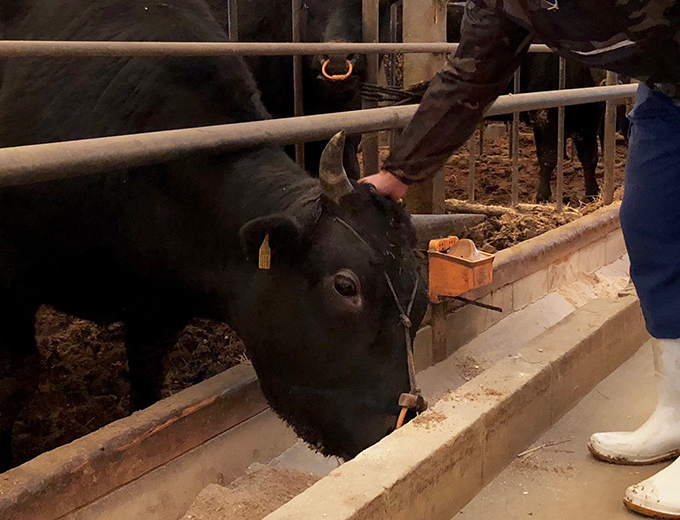

Blessed with a rich soil and a warm climate, Fukuoka Prefecture is also a thriving livestock center. The ingredient brands taking the prefecture’s name embody the producers’ dedication.
-
 foods 01
foods 01Hakata Wagyu Beef
To produce this beef, all the Japanese cattle producers in Fukuoka Prefecture have worked together with their determination to deliver to consumers safe, reliable, and delicious beef. Of the Japanese black cattle raised carefully in the prefecture by certified producers over at least 12 months, only those cattle whose meat quality is graded at least 3 can be referred to as Hakata Wagyu. Approximately 3,000 cattle are shipped annually. Fed with high-quality rice straw from the prefecture, the cattle feature juicy and delicious beef. Hakata Wagyu, the fruit of the producers’ passion and dedication and the blessings of Fukuoka as a rice production center, has been commended for its excellence and received an honorable mention at the nationwide Japanese cattle competition known as the Wagyu Olympics.
-
 foods 02
foods 02Hakata Jidori Chicken
Satisfying various strict standards, this special local chicken constitutes only about 1% of all the chicken shipped nationwide. Ahead of other prefectures, Fukuoka developed a local brand of chicken, or Hakata Jidori, in 1987. The chicken features a crispy texture, as well as a pleasant savor that comes out more and more as it is chewed. At 10 designated farms in the prefecture, all Hakata Jidori are fed with the same exclusive feed and raised for at least 80 days. In FY2021, approximately 50 million chickens were shipped, making Fukuoka ranked No. 1 in Kyushu and No. 3 in the country for five years in row.
-
 foods 03
foods 03Hakata Ichiban-dori Chicken
Developed by Fukuoka Prefecture in 1999, this brand of chicken is rich in inosinic acid, which is often used as a flavor enhancer. Compared with ordinary chickens raised quickly, the chicken contains approximately 15% more inosinic acid. It has a deep savor and a good texture. At seven designated farms in the prefecture, all Hakata Ichiban-dori are fed with the same exclusive feed and raised for 62 days on average.

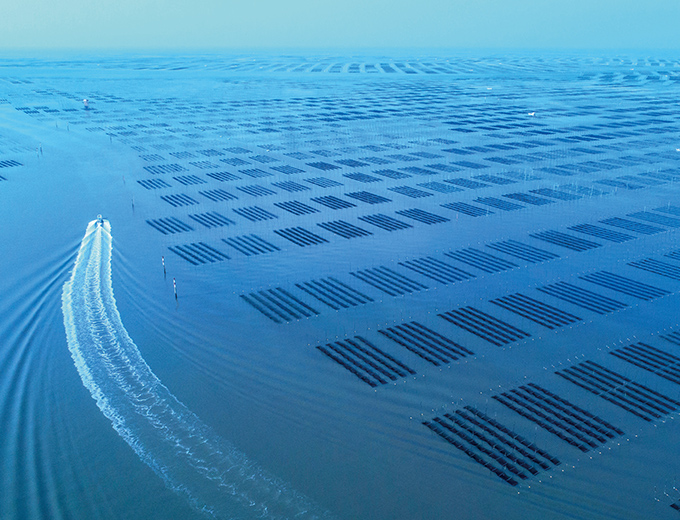

Surrounded by the Chikuzen Sea, the Ariake Sea, and the Buzen Sea, all of which have different features, Fukuoka has many inland waters, such as rivers, lakes, and marshes. These waters are home to various fishing and aquaculture industries. A wide variety of fish and seafood make Fukuoka tables even more attractive.
-
 foods 01
foods 01Natural Red Sea Bream
Fukuoka Prefecture boasts one of the largest catches of natural red sea bream in Japan, and the fish are caught mainly in the Genkai Sea, which spreads out to the northwest of the prefecture. Growing up in the rough waves of the Genkai Sea, natural red sea bream have thick and beautiful white meat with a firm texture and an elegant flavor. This is a representative example of the fish from Fukuoka. While carefully preserving the sea environment, local fishermen strive to conserve resources. For example, they release red sea bream to the sea if they are small when they are caught, in order to ensure that red sea bream remain available.
-
 foods 02
foods 02Conger Eel
Growing up in the rough waves of the Genkai Sea, conger eels are characterized by their firm flesh with an appropriate amount of fat. One of the prefecture’s main catching areas is Munakata City, well known for its inscription on the World Heritage List as an element of The Sacred Island of Okinoshima and Associated Sites in the Munakata Region. To catch the fish, cages with bait in them are set on the seabed, meaning that they are less likely to be damaged and are caught alive.
-
 foods 03
foods 03Ipponyari Squid
Caught carefully in the Genkai Sea one at a time, this is a long-finned squid a long-finned squid whose trunk measures at least 15 cm long. The shape of the squid when caught and its transparent appearance remind locals of the anecdote on Nihon-go, touted as one of the three greatest spears in Japan and associated with the Kuroda clan, leading the squid to be named Ippon-yari (single spear). The squid’s flesh has a pleasant texture, and its pleasant, sweet flavor melts in the mouth when chewed. Once caught, the squid is removed from the hook with minimal contact, placed in a seafood tank, and delivered to a port with the utmost care.
-
 foods 04
foods 04Conger Pike
The conger pike caught in the Buzen Sea from summer to autumn is a fresh fish with strong vitality and rich nutrition. After the spawning season, which begins at the end of the rainy season, the fish is in season with a good level of fat on them. Its thick white meat has a plain taste and a soft texture. In the Buzen Sea, conger pike are caught with a trawl. To preserve their freshness, they are live-fished and drained of blood just before shipment.
-
 foods 05
foods 05Tokusen Honzawara Mackerel
Of the Spanish mackerel weighing at least 2.5 kg and caught with a pole and line by fishermen of the Itoshima Fishermen's Cooperative, only those processed to ensure high quality can be called Tokusen Honzawar. Once caught, the fish are processed quickly and cooled with iced water. These steps make the flesh firm and enhance the savor. Featuring delicate fat and savor which are realized by the local fishermen's excellent skills, the fish is popular both inside and outside the prefecture.
-
 foods 06
foods 06Fukuoka Ariake Seaweed
This is grown on the tidal flats of the Ariake Sea, one of Japan’s largest seaweed producers, through leverage of the country’s largest difference between high and low tide. At low tide, the seaweed is exposed to warm sunlight in winter, while at high tide, it grows in the sea water rich in nutrition coming form the Chikugo River, the largest river in Kyushu, and other class A rivers, such as the Yabe River, giving the seaweed a soft texture and an excellent flavor. Fukuoka Ariake Seaweed is a fruit of the natural environment of the Ariake Sea and the fishermen’s constant efforts and excellent skills. This first-class item is rich in flavor, melts smoothly in the mouth, and pleases the palate.
Photo courtesy of Fukuoka
Prefecture Tourist Association
